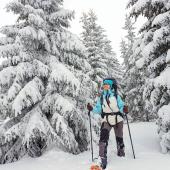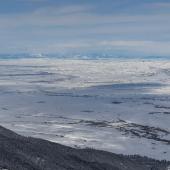Park in Peril
The effects of climate change are already evident, and the stakes are high for outdoor enthusiasts and nature lovers living in southwest Montana who recreate year-round in Yellowstone National Park. The reasons we live here—lush forests, mighty grizzly bears, powdery snow—are at risk because of climate change. “The global climate is changing,” the National Parks Service (NPS) reports, “and is already affecting the Greater Yellowstone Ecosystem.”
The Park, which is at the heart of the Greater Yellowstone Ecosystem (GYE), is home to one of the last protected diverse ecosystems on Earth. It is also the nation’s first National Park, and that stands to help its chances of adapting to and surviving climate change, as the Park plays host to more research and investment because of its status. Scott Christensen, Climate Change Program Director at the Greater Yellowstone Coalition (GYC), puts it best: “Yellowstone has a worldwide following, so there’s a lot of interest in climate change here from all over the world.” The Park therefore plays a special role in the bigger picture of climate change, too—for instance, it can help tell the story of its afflicted species, including the wolverine and lynx, and how those species will fare in other parts of the world.
And the story of its afflictions is already being told. The Park has seen a reduction in the length of the snowpack season; Greg Pederson, a research ecologist for the U.S. Geological Survey (USGS) who specializes in issues related to climate change, says that “warmer temperatures in late winter and early spring are driving decreased overall snowpack and the earlier melt out of snow from the mountains,” resulting in a longer wildfire season. Longer, warmer summers are causing rivers to have lower baseflows, meaning warmer water temperatures and thermal stress on native Park fish like cutthroat trout. And the lack of harsh winter cold has caused a proliferation in the ubiquitous mountain pine beetle and subsequent devastation of the whitebark pine. Predictions for the future are, not surprisingly, even more grim.
The Science
By now, most scientists agree that greenhouse gases built up over time because of human activities like burning fossil fuels are trapping the heat that naturally radiates from the Earth’s surface, lending to the global warming trend. “When you increase CO2,” Pederson explains, “you increase global and regional temperatures,” because the CO2 in the atmosphere blocks outgoing radiation. And as temperatures increase, snow and ice melt, covering less of the Earth, and thus, as the NPS explains, “less thermal radiation is reflected, and more heat is absorbed by the increasing amounts of open water and bare land. This increased absorption increases surface and air temperatures.”
Reliably non-partisan organizations like the NPS and NASA have concluded that climate change is almost certainly human-caused. “There’s incredibly strong evidence that backs up anthropogenic causes for global warming,” Pederson (a researcher for another reliably non-partisan organization) says. A report compiled by the Rocky Mountain Climate Organization and the GYC in September 2011 says, “Human activities have led to large increases in the atmospheric concentration of heat-trapping gases, which already is changing the climate, around the world and in Greater Yellowstone.”
Yet doubters persist, and insist that climate change is either non-existent or is a natural Earth cycle. Consider this: ice core records show that over the last 5,000 years since the last glacial period, CO2 concentrations rose 80 parts per million (ppm). In the last 100 years alone, though, CO2 concentrations have risen 79 ppm. “At the end of the day,” Christensen says, “if we stay on the trajectory that we’re at with carbon emissions, the speed at which things will change will be such that habitats and species will have a hard time adapting.”
The Effects
The NPS predicts that climate change in the Park, and therefore changes in precipitation and temperatures there, “will likely disrupt vegetation growth.” Of particular concern is the whitebark pine, which is already seeing several different but simultaneous effects of climate change. Whitebark pine is important because of the many roles it plays in the GYE: the trees grow where other, less sturdy trees cannot, and therefore control erosion; their seeds provide food for grizzly bears and other species; and they sustain late-season water flows by creating shade and slowing snow melt.
One of the largest contributing factors to the trees’ decline is the mountain pine beetle: as temperatures warm due to climate change, the beetle’s life cycle is longer because it’s not killed by sufficiently cold winter temperatures. The beetle outbreaks, combined with an increase of drought-stressed trees, and an increased number of wildfires (necessary to the survival of whitebark pines) and thereby human suppression, have contributed to the decimation of the trees. On top of that, the non-climate-related introduction of white pine blister rust threatens trees’ survival even more. The Fish and Wildlife Service (FWS) has identified that, “based on these threats, the whitebark pine is in danger of extinction, or likely to become so in the foreseeable future.” Aspens, too—among the only deciduous trees in the Park—are so ill suited to warmer temperatures that they face near-total elimination in the not-too-distant future.
According to the NPS, that disruption in vegetation growth “in turn would seriously disrupt wildlife migrations.” As food sources like the whitebark pine disappear, species will need to adapt, to move around on the landscape to find other food sources. The easier it is for a species for migrate, the better its chances of survival. That’s where man-made obstacles—highways, fences, subdivisions—present problems in the scope of the climate-change dilemma. Species will simply not be able to relocate to find food if they’re hindered by obstructions. “The concept of migration and connectivity is going to be really important for wildlife as our climate changes,” Christensen says. Luckily, the Park, which is a vast and largely protected area of land, will be better able to defend affected species than will many other wilderness areas—yet another reason to protect the natural integrity of the Park.
The grizzly bear, which depends on whitebark pine seeds for sustenance in the fall as a primary pre-hibernation food, is likely to have a lower survival rate in connection with the lower survival rate of the whitebark pine. And common sense can tell anyone that a decrease in whitebark pine seeds will likely lead to more human-bear interactions as the bears seek out new sources of food. “As that food source is diminished,” Christensen says, “grizzly bears have to range more widely looking for food. A lot of times that puts them in places where there are more people.” Other mammals likely to be affected by climate change include the less-adaptable pika and wolverine, whose survival is directly linked to the snowpack. Both species “require deep snow in the spring to dig their dens and reproduce successfully,” Christensen says. “If there’s not deep snow in the spring, then that’s going to be a problem.”
Fish, too, are likely to see dramatic effects because of climate change. “Accumulated snowpack and snowcover have declined to nearly unprecedented lows since the 1980s relative to the past 800 years of snow history,” Pederson says. As the snowpack and snowcover decrease, the amount of water in streams also decreases, and that increases water temperatures. “Cutthroat trout and trout in general have relatively low temperature tolerances,” says Robert Al-Chokhachy, a Research Fisheries Biologist at the USGS. “Stream temperatures have strong influences on fish metabolic rates, and above certain thresholds, trout cannot survive.”
Climate change—in coordination with the introduction of non-native trout species and habitat degradation—amount to what is likely to be a noticeable loss of trout population in the future, in rivers like the Yellowstone and Colorado. From a fisherman’s perspective, Al-Chokhachy says, “this means higher probabilities of angling closures during the summer.” Even if water temperatures alone were not high enough to kill the fish, the stress of catch-and-release fishing, in combination with temperature increases, would be enough to kill the trout.
In terms of recreation, less snow and shorter winters also mean less skiing, snowshoeing, and over-the-snow travel—that not only means less fun, but also less tourism and less money. Higher temperatures and less rain mean flooding and wildfires, and threats to homes and people. “Summertime extreme temperatures over the past century have increased in frequency and duration,” Christensen says, “contributing to the rapid dry-down of forests and increased risk of wildfire activity during the summer.” Many scientific studies predict more wildfires like those that occurred in 1988, during which—on two separate occasions—more than 4,000 people were evacuated from areas within the Park.
The Future
The debate over whether climate change is human-caused—and even whether it’s happening—will probably continue for years. But for local conservationists like Christensen, the reason behind what’s causing climate change ends up mattering little; it’s easy to see that changes are happening, and his job is now to stay one step ahead. “It’s not super helpful to spend a lot of time on the front end debating about why the change is happening,” Christensen says. “The question is, can we find some solutions here to help deal with the change that is happening?”
For fish, that means it’ll be important to “give [them] opportunities to survive through periods of stress associated with [higher] temperatures,” Al-Chokhachy says. “This means figuring out ways to increase riparian shading, being more efficient in water use, providing access to colder, often headwater streams, and reducing factors limiting cutthroat trout survival, including non-native fish.” For wildlife, that means doing things like reducing existing stressors to their habitats and protecting natural movement and migration. The same goes for vegetation and water sources—fixing existing problems and identifying short-term solutions to prevent further damage—in an effort to prepare the landscape for the inevitable transformation that climate change will bring.
“I think about it as a human body,” Christensen says. “If you are sick and all of a sudden you have some big stressor in your life—you lose your job or someone in your family passes away—you’re less resilient and you’re less capable of responding. But if you’re in peak physical and mental condition and you have an event like that happen to you, you’re more capable and better able to respond. It’s the same thing with climate change and with the health of our habitats in the region.”
The story of climate change in the Park is an interconnected, wide-reaching, complicated story of interactive ecosystems responding to each other. What’s in this article is only a fraction of the bigger picture of climate change in the GYE, from vegetation and wildlife to recreation and economics. So, some of you might ask, Why dwell on the negative? To borrow Dr. Steven Running of the University of Montana’s model, to help both the doubters and the hopeless to the final stage of the “Five Stages of Climate Grief”: acceptance. Only after we have accepted that the consequences of climate change are real can we begin to mend our ways in time to save the places we love.
Go to the Park—watch the sun set over the Tetons, or wolves play in the Lamar Valley—and remember the connection you feel to the land and the animals. Then take that passion and turn it into action. Demand change from your lawmakers, local and national; reduce your carbon footprint; donate your time and money to the cause; spread the word to the ones you love. As humans, it’s not easy for us to think beyond our day-to-day commitments (let alone decades and centuries in the future), but accepting that climate change will not transform the landscape overnight is just another challenge we face—one we must face head-on if we are going to save Yellowstone.
Illustration by Mike Russo












